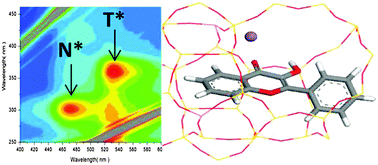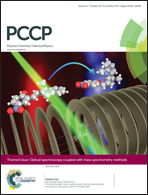Spectroscopic evidence of 3-hydroxyflavone sorption within MFI type zeolites: ESIPT and metal complexation†
Abstract
Due to its chemical and photochemical properties and potential applications in numerous domains as a molecular probe, 3-hydroxyflavone (3HF) is a molecule of high interest. In particular, the processes of intramolecular proton transfer in the excited state and metallic complexation are known to be dependent on the chemical environment. In this context, the particular properties of zeolites make these microporous materials an environment adapted to study the reactivity of isolated molecules adsorbed in their porous void space. Thus, this report investigates the incorporation without any solvent of 3HF into the internal volume of various channel-type MFI zeolites. Using complementary techniques (diffuse reflectance UV-vis absorption, Raman scattering, FTIR, fluorescence emission and molecular modelling), very different spectral behaviours are observed in totally dealuminated silicalite-1 and in Al rich MZSM-5 (M = H+, Na+, Zn2+). In silicalite-1, the non-polar and non-protic internal micro-environment does not induce any valuable interaction between 3HF and the channel walls. Therefore, the molecule shows easy tautomer formation upon excitation. Within HZSM-5, 3HF is adsorbed in close proximity of the acid proton of the zeolite which inhibits the intramolecular proton transfer and then, only the normal form is observed at the excited state. For NaZSM-5, the spectral data show an intermediary behaviour due to the aprotic but polar environment, in agreement with 3HF sorption in close proximity of the Na+ extra framework cation. After mixing 3HF and ZnZSM-5, the spectral features clearly indicate metallic complexation of the guest molecule. The zeolite dependent reactivity reported here demonstrates the adsorption of the guest within the internal volume because the charge balancing cations which clearly control the reaction are principally located in the zeolite channels. The 3HF incorporation into the internal volume is proved by the decrease of the microporous volume observed by nitrogen adsorption–desorption isotherm measurements. The experimental data are confirmed by Monte Carlo molecular modelling which also predicts 3HF sorption in the zeolite channels in the proximity of charge compensating cations. Consequently, as the molecule dimensions are assumed to be slightly larger than the channel size, the flexibility of the molecule and the lattice deformation have to be considered to allow 3HF penetration into the zeolite void space.


 Please wait while we load your content...
Please wait while we load your content...